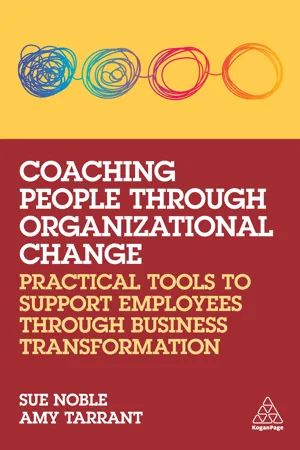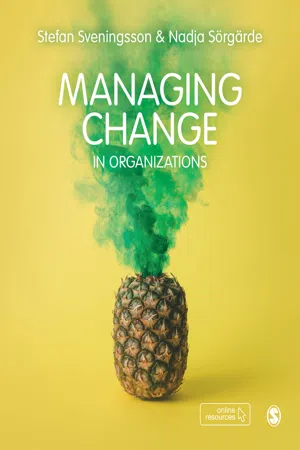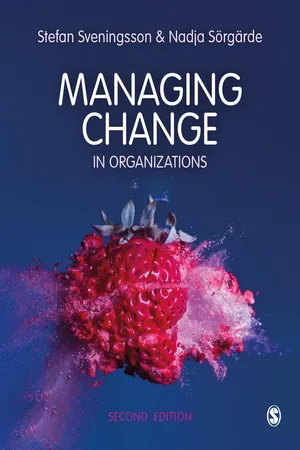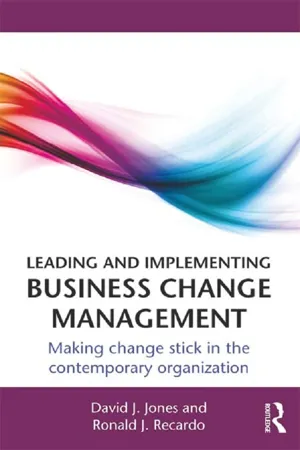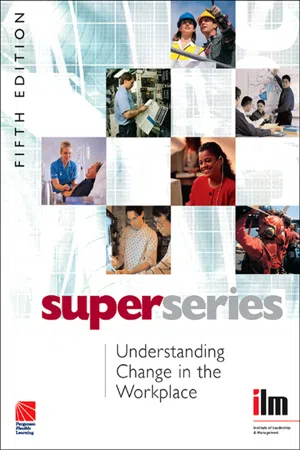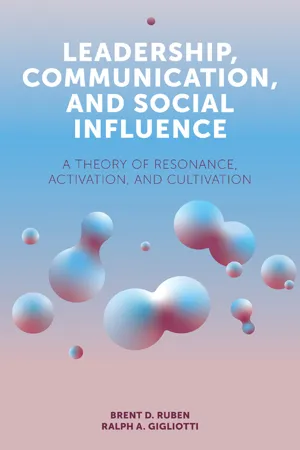Business
Resisting Change
Resisting change refers to the reluctance or opposition to adopting new processes, technologies, or strategies within an organization. This resistance can stem from fear of the unknown, lack of understanding, or attachment to the status quo. It often hinders organizational growth and innovation, making it crucial for businesses to address and manage resistance effectively.
Written by Perlego with AI-assistance
Related key terms
Related key terms
1 of 4
Related key terms
1 of 3
11 Key excerpts on "Resisting Change"
- eBook - ePub
Coaching People through Organizational Change
Practical Tools to Support Employees through Business Transformation
- Sue Noble, Amy Tarrant(Authors)
- 2022(Publication Date)
- Kogan Page(Publisher)
07Resistance to organizational change
Introduction
This chapter considers what is arguably the largest challenge facing any organizational change practitioner – resistance. In his 1969 Harvard Business Review paper, Paul Lawrence dubbed it ‘one of the most baffling and recalcitrant of problems which businesses face’ and any seasoned change professional knows how true this is.Many of us will have encountered resistance in our personal lives and instinctively know what it means.In an organizational change context, there are several definitions from different academics, theorists and practitioners but in his 2003 research at Cornell University, Shaul Oreg provides perhaps the most comprehensive:[an] individual’s tendency to resist and avoid making changes, to devalue change generally, and to find change aversive across diverse context and types of change.This resonates because it not only correctly identifies the individual’s negative reaction to all types of change but also highlights the tendency to devalue change as a concept. The latter is crucial because it increases the likelihood of detractors sharing this sentiment with others and spreading resistance.The aim of this chapter is to:- Describe the scenarios that resistance causes in the delivery of change.
- Highlight some of the key root causes to the resistance, using a variety of models and frameworks to understand why people react the way they do.
- Share practical change management tools to mitigate and sometimes remove resistance.
- Propose coaching and mentoring frameworks and techniques that can be applied in conjunction with the traditional change approach.
Over the years, countless resistance models and frameworks have been put forward by academics and practitioners alike and it is not the authors’ intention to include them all. On the contrary, this is a hand-picked set of change and coaching techniques which have proved invaluable to the authors and which work well together. - eBook - ePub
Managing Change in Organizations
How, what and why?
- Nadja Sörgärde, Stefan Svenningson(Authors)
- 2019(Publication Date)
- SAGE Publications Ltd(Publisher)
Explaining resistance as a psychological and individual phenomenon has been heavily criticized (Dent & Goldberg, 1999). One criticism is the assumption that employees automatically resist changes because uncertainty is always seen as a threat. In contrast, it is said that what employees mostly react to in change processes is the worsening of their work conditions, such as a lower status, a reduced income or a heavier workload. Criticism has also been directed at the individualization of resistance. When resistance is largely seen to be based on individual people, this overshadows the social change dynamic and the significance of relationships and group dynamics as a basis for resistance.In other words, there is a strong argument against limiting resistance to change to psychological explanations. In the next section we discuss alternative ways to understand and relate to resistance to change.Review questions 9.1
Political resistance
According to a political perspective, an organization is not assumed to be a coherent unit by default. It is rather understood as a number of more or less loosely connected coalitions of people with different interests and goals. In this context, resistance is a matter of people reacting to changes that they perceive to threaten their interests in some way.From this perspective, resistance to change can be understood as employees (individually or in groups) fighting to protect their interests, power and influence, which they perceive to be under threat (e.g. Cummings & Worley, 2009). In practice, this can mean that the work situation worsens to some degree. It can involve people being at risk of losing their jobs, or that their workload increases, or that people can no longer work with their preferred colleagues, or that they are given less interesting and rewarding tasks, or that they are forced to do things (such as administration) that does not match their professional experience, and so on. It can also mean that the change is managed in a way that undermines individuals’ or groups’ abilities to exert influence, informally and/or formally. In other words, this perspective goes beyond the idea that resistance is primarily about uncertainty of the unknown. Even if the organizational members had known the very finest details of the change plans, this would not have been any guarantee that they would have accepted them. Rather, knowledge about the changes creates resistance because people then know they stand to lose something, in one way or another, if the changes are implemented (Pfeffer, 1992). - eBook - ePub
Change Lessons from the CEO
Real People, Real Change
- Patrick C. Flood, Johan Coetsee(Authors)
- 2013(Publication Date)
- Jossey-Bass(Publisher)
‘I would certainly say make change a normal part of corporate life; encourage, train and educate your people to understand that change is a good thing, that they need not be frightened of it, that change brings with it opportunity and progress and if you stay still too long these days, or you have a workforce that feels you ought to stay doing the same thing because that must be better mustn't it? You're going to get disintermediated, disenfranchized or just beaten in the market, you have to – and I say the way you do that as a leader is through communication, it's something that leaders never ever spend enough time and effort on, which is communicating cogently and sensibly – not through webcasts and emails and stuff, but actually getting out there, talking, meeting, being visible and using anecdotes and story-telling to show people that change is not a bad thing, change is a good thing, in fact it's a necessary thing, in order to get to the future that we all wish to have. I think, again, change for change's sake is a very dangerous thing so first off, as a leader, you have to set the vision, its got to be clear. Then you've got to set the objectives very clearly for the organization and for every part of the organization, then you've got to set the framework of behaviours within which you expect people to behave. But beyond that, as a leader, your job is to communicate, to counsel, to support, to coach, to listen, to observe, to enthuse, to inspire – that's the job of a leader and if you've got the vision, the objectives and the framework of behaviours, then actually, change is fine, because you've always got to shift your way towards that elusive vision that you have. The more comfortable you get talking in those terms the more comfortable your people will be. And I think the other thing is behaviour breeds behaviour, if you as the leader behave in a way that's perfectly comfortable with change; “Change is just a great thing! I love change, it's fantastic!” then that behaviour will be breeding behaviour in your own people and their people and you know, it cascades down the organization.’Change should not be an add-on, it should be integrated in organizational lifeCreate and develop employee capacity to changeBe visible and communicateKnow ‘why’ the change is needed and where are you goingDemonstrate behaviours such as communication, coaching, counselling and listeningWalk-the-talkRethinking Resistance to Change
Resistance to change is frequently used as a reason why transformation efforts fail and managers have many terms to describe resistance for example not buying into the change, people are negative, they are dragging their feet and so on. They classify resistance using a range of behaviours they don't like and this may range from employees asking an innocent question (to clarify), to a roll of the eyes or to blatant sabotage. Davidson (1994, p. 94) states that the term resistance has come ‘to include anything and everything that workers do which managers do not want them to do, and that workers do not do that managers wish them to do …’. The concept remains loosely defined, allowing some managers to see it almost everywhere and others almost nowhere (Weitz, 2001). The concept has been defined in many different ways, for example: resistance can be regarded as opposition, reaction or force that inhibits change (Piderit, 2000), a restraining force (Lewin, 1951) or as a positive force that can be used to challenge and refine change strategies (Mabin et al., 2001). It is also possible that ‘resistance to change is an interpretation assigned by change agents to the behaviours and communications of change recipients, or that these interpretations are either self-serving or self-fulfilling’ (Ford et al., - eBook - ePub
- David Courpasson, Steven Vallas, David Courpasson, Steven Vallas(Authors)
- 2016(Publication Date)
- SAGE Publications Ltd(Publisher)
20 Organizational Change and Resistance: An Identity PerspectiveSierk Ybema, Robyn Thomas and Cynthia HardyINTRODUCTION
A classic term in popular and scholarly literature on change management is ‘resistance to change’. It understands resistance in terms of opposition to managerial strategies for organizational change. Since change is generally viewed as reasonable and desirable within this literature, resistance to change promulgates the image of employees digging in their heels, refusing to offer support, and hindering a natural and necessary course of events (e.g., Kotter and Schlesinger, 1979). More recently, some change management scholars have embraced a more positive framing of resistance by viewing it as an opportunity to generate ‘conversations’ about change by involving employees, although ultimately with the aim of securing support for change (e.g., Ford et al., 2008). Resistance according to this view becomes instrumental to the strategies pursued by management. Critical scholars challenge both these views of resistance by rejecting a managerialist agenda. Instead, they are sceptical of managerially imposed change and conceptualize resistance as legitimate attempts by employees to repudiate initiatives that may benefit organizational interests, but which will impact negatively on their interests and working conditions (e.g., Thompson and Ackroyd, 1995). - eBook - ePub
- Stefan Sveningsson, Nadja Sörgärde(Authors)
- 2023(Publication Date)
- SAGE Publications Ltd(Publisher)
In this context, resistance is a matter of people reacting to changes that they perceive to threaten their interests in some way. From this perspective, resistance to change can be understood as employees (individually or in groups) fighting to protect their interests, power and influence, which they perceive to be under threat (e.g. Cummings et al., 2020). In practice, this can mean that the work situation worsens to some degree. People may think they are at risk of losing their jobs, or that their workload will increase, or that people can no longer work with their preferred colleagues, or that they are given less interesting and rewarding tasks, or that they are forced to do things (such as administration) that does not match their professional experience, and so on. It can also mean that the change is managed in a way that undermines individuals’ or groups’ abilities to exert influence, informally and/or formally. In other words, this perspective goes beyond the idea that resistance is primarily about uncertainty of the unknown. Even if the employees know the very finest details of the change plans, it does not guarantee that they will accept them. Rather, knowledge about the changes creates resistance because people then know they stand to lose something, in one way or another, if the changes are implemented (Pfeffer, 1992). Another way of expressing it is that the individual’s ‘implicit contract’ changes for the worse (Watson, 2006). This means that employees perceive that the tacit agreement about what efforts they are supposed to put into work, in relation to the rewards and benefits given in return (see Figure 9.1), has been broken or is unbalanced. It does not necessarily mean that only their job or specific work duties are threatened, but also that the individual’s identity is challenged or questioned, as individuals’ identities are often closely associated with their working life (Sveningsson & Alvesson, 2016) - eBook - ePub
Managing Change in Healthcare
Using Action Research
- Paul Parkin(Author)
- 2009(Publication Date)
- SAGE Publications Ltd(Publisher)
Piderit (2000) explains that individuals’ responses may lie anywhere along the continuum of each dimension ranging between extreme positives and negatives. She also outlines that the separate dimensions allow for different reactions along different dimensions. This means that someone can show ‘ambivalence’ about change where a positive cognitive response (this change is good for the department) may conflict with a negative emotional response (I don’t want to lose my role). Behavioural ambivalence may exhibit in an individual through covert opposition (by sending anonymous feedback comments) whilst demonstrating public support through fear of management retribution.Pardo del Val and Martinez Fuentes (2003: 149) and Hunt (1992: 291) define resistance as ‘any conduct which attempts to preserve the status quo’ in the face of pressures or actions to alter it. Hunt argues that resistance is the most frequently cited reason for failure in organizational change and is linked with feelings of fear, uncertainty and a perceived loss of control.Other writers disagree: Kegan and Lahey (2001: 85) state that ‘resistance to change does not reflect opposition, nor is it the result of inertia’, rather people display a ‘personal immunity to change’ (see below).Ford et al. (2002) note that when resistance is objectified to the individual, management strategies focus on changing those individuals rather than wider systems. This not only creates more resistance but is far removed from Lewin’s original conception that resistance is diffused throughout a system.The emerging view
Giangreco and Peccei (2005) note that recently a more objective and positive approach to resistance is being taken. Pardo del Val and Martinez Fuentes (2003) argue that since change in organizations is not always beneficial, so attempts to avoid change through inertia and resistance cannot necessarily be seen as negative. Others point to the positive aspects of resistance. Lamb and Cox (1999) argue that resistance to change is healthy and that without real questioning and scepticism it is unlikely that an organization can progress to a productive stage of learning and working in any new structure. Mabin et al. (2001) argue that resistance is better than apathy as it avoids group-think and provides more alternatives from more people. - eBook - ePub
Leading and Implementing Business Change Management
Making Change Stick in the Contemporary Organization
- David J. Jones, Ronald J. Recardo(Authors)
- 2013(Publication Date)
- Routledge(Publisher)
4 CHANGE RESISTANCE“A new philosophy, a new way of life, is not given for nothing. It has to be paid for and only acquired with much patience and great effort.”1Fyodor DostoevskySITUATIONAL CONTEXT FOR CHANGE RESISTANCEResistance is a high risk for change initiativesYour change initiative has been rolled out. The change master plan is in place and the change vision, goals, and benefits have been thoughtfully crafted and communicated at a town hall meeting by the change leadership team. Things should be progressing, and you expect to find an abundance of uplifting energy across the initiative. But as you walk the halls, pop in to teamwork sessions, and listen in on candid conversations between your leaders, it becomes clear that people are holding back. Attitudes, behavior, and energy are not flowing in a unified, positive direction. Resistance is impeding your organizational change initiative. You need to get the resistance out on the table, find out what is causing it, and implement actions to address it.On a change initiative, leaders need to identify resistance, surface its underlying causes, and address the causes efficiently and effectively. This cycle of identifysurface-address resistance should be performed at the outset of the change initiative and continued periodically throughout its duration. If resistance is not sufficiently addressed, the minds and hearts of those in the organization will not transition to the desired state of change. When implementing change stakeholders’ hearts and minds have to be aligned. Individuals may understand the business case for change but still need time for their emotions to catch up before they can embrace change.Why do stakeholders and other members of the organization resist change?• People are afraid of uncertainty and the unknown, including what they perceive they might lose. Natural human anxieties and concerns about change, as described in Chapter 1 , are organic and common to individuals. These concerns collect, grow, and intensify around efforts to change the organization. This resistance can negatively impact and disable change initiatives, as described in the IBM study on the causes of organizational change initiative failure cited in Chapter two - eBook - ePub
- Institute of Leadership & Management(Author)
- 2007(Publication Date)
- Routledge(Publisher)
2 The missing word in the following statement begins with P. What is it? Among the main underlying causes of people's resistance to change is that they see it as a threat to their position, prospects and __________.3 In any change situation, there will be forces supporting and forces opposing the change. When faced with forces opposed to change, which two of the following should you do?Increase the supporting forces.Maintain the supporting forces at their present level.Reduce the opposing forces.Ignore the opposing forces.4 Fill in the missing words. a Where change is concerned, __________ is the best antidote to resistance. b __________ is the best medicine for uncertainty. c __________ is infectious.INFORMATION PLANNING ENTHUSIASM CHANGE PARTICIPATION ASSERTIVENESS Answers to these questions can be found on page 81 .5 Summary
Resistance to change is normal.When you react negatively to the prospect of change, it may be because you see it as a threat to position, prospects or prosperity, or because you are uncertain about what it will bring.As a manager, you need to take the lead in overcoming your initial negative reactions to proposals for change and focus on how to respond in a constructive way.Before announcing any major change, it is essential to know what the main implications of that change will be.In any change situation, there will be forces supporting and forces opposing the change. As a leader of change, you need to work on maintaining the forces that support a change and reducing those that oppose it.Two-way communication has a major role to play in preparing people for change during the ‘unfreezing stage’ of a change programme.The three main ingredients of the recipe for successful change implementation are as follows.ParticipationInformationEnthusiasmWhere change is concerned, participation is the best antidote to resistance.Information is the best medicine for uncertainty arising from change. - eBook - ePub
Leadership, Communication, and Social Influence
A Theory of Resonance, Activation, and Cultivation
- Brent D. Ruben, Ralph A. Gigliotti(Authors)
- 2019(Publication Date)
- Emerald Publishing Limited(Publisher)
resistance. A general resistance to change exists at all levels of life. Our immune system resists intrusions that threaten our biological well-being, our psychological system resists perceived threats to our emotional and cognitive stability, and organizations, communities, and societies resist threats to the existing order (Von Bertalanffy, 1968; Ruben & Kim, 1975). In such situations, cultivated habits, traditions, and histories mitigate against support of new directions, and often contribute to the disregard or distortion of messages and strategies aimed at promoting change.Personal as well as organizational change initiatives and associated messaging, processes, strategies, and structures are particularly unlikely to resonate in supportive ways when the proposed change has one or more of the following characteristics (Ruben et al., 2017):- comes as a surprise;
- is not deemed to be necessary;
- requires a substantial investment of time, when there is already too much to do;
- calls for new routines, knowledge, or skills;
- assumes resources that may not be present or forthcoming;
- undermines one’s sense of self or identity;
- threatens present status, stature, or roles;
- generates mistrust and a perceived lack of confidence in leaders; and
- implies a criticism of the present messages, systems, processes, and/or structures.
Because resistance can impede progress on leadership plans and goals, leaders generally regard it as a problem and typically make efforts to circumvent or overcome the resistance in some way. More thoughtful analysis, however, reveals that resistance is not without value. For example, with careful listening, voices of resistance can provide important clues to the reasons for an absence of supportive activation, and can also provide insights into potential cultivation strategies which can be useful for moving toward the desired outcomes. - eBook - ePub
Leading and Managing in Contemporary Health and Social Care,E-Book
Leading and Managing in Contemporary Health and Social Care,E-Book
- Elizabeth Anne Rosser, Cate Wood(Authors)
- 2022(Publication Date)
- Elsevier(Publisher)
Changes in behavior result either from a decrease in the power of restraining forces or an increase in the power of driving forces. Interestingly, one finding is that lack of workers’ participation in discussions of the envisaged changes was directly linked to aggression and turnover rates. Hon et al. (2014) suggest two main aspects that remain important today. First, resistance is connected to shortcomings in the interactions between individuals and the organization—in the planning or execution of the process of change, through poor human resource management, or wrongly placed or missing incentives. Second, employees must actively participate in the change management process and the intersection between organizational factors and the focus on individual and group self-interests and/or psychological makeup. Choi and Ruona (2011) highlight that the relationship between change strategies and organizational culture can impact the perception of individual readiness for organizational change. Vakola (2014) develops this further by categorizing organizational readiness into three levels—micro-individual, meso-group, and macro-organizational readiness—and by considering personality characteristics. Likewise, Wraikat et al. (2017) examine the readiness level, highlighting factors such as organizational structure, organizational climate, technology implementation strategy, and employee perceptions in psychological contracts on acceptance of change. In a health and social care context, Packard et al. (2015) note that in 13 countries, change readiness, change capacity (management and organizational capability), and a participative leadership style are all important factors for sustaining change. Allied with this, Rogers’s (2003) classical work on diffusion of innovation remains a useful model for its resonance within the health and social care sector, especially where the theory identifies the rates at which staff members are motivated to accept changes (Box 11-8) - eBook - ePub
- Larry S. Miller, Harry W. More, Michael C. Braswell(Authors)
- 2017(Publication Date)
- Routledge(Publisher)
resistance. When a change is viewed as threatening, most employees will resist it.If the change is immaterial or of no consequence, it will, in all probability, not be resisted. If, in fact, the change proves to be supportive or helpful, everyone will most likely welcome it. Resistance to change is viewed mainly as an effort to maintain the status quo. In part, resistance occurs because of the fear of the unknown. It may be thought that a new procedure may be more difficult to use than the current system. Acceptance of many change efforts can be thwarted unless it is totally supported by top management. It is also essential to communicate a change effort to all involved in the organization, especially when it is a major shift in policy or procedures that will affect the culture of the organization. Needless to say, officers must receive effective training concerning expected changes. Nothing can be left to chance. It will be necessary to hold meetings in order to orient personnel about the changes and to convince officers that the changes are beneficial and important not only to them, but also to the organization. Officers need to be told about their proposed responsibilities and duties. This is especially true when basic assumptions about the police function have to be changed and there is a transition from a traditional system to one that emphasizes newer concepts (Alpert et al., 1998).When change is implemented operationally, it may require members of the organization to behave in an entirely different manner, require more effort, or require officers to learn new things. It might be associated with the creation of a new working environment and seem to contain a number of imponderables that affect how officers perceive things and, above all, how they affect their personal well-being. In other words, is there a loss, tangible or intangible (Mastrofski, 2007)?
Index pages curate the most relevant extracts from our library of academic textbooks. They’ve been created using an in-house natural language model (NLM), each adding context and meaning to key research topics.
Explore more topic indexes
Explore more topic indexes
1 of 6
Explore more topic indexes
1 of 4
